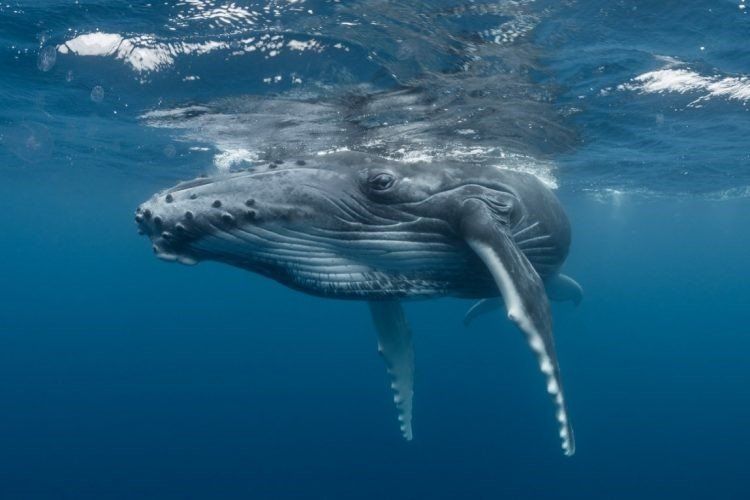Humpback Wails: Feeding Calls from Solitary Humpback Whales
Humpback whales, Megaptera novaeangliae, occupy near shore waters throughout the world. They typically feed on krill and small fish, such as mackerel and herring. Humpback whales are known for their complex acoustics, which include both song and non-song vocalisations.
Typically, songs are associated with reproductive behaviour, whereas non-songs are associated with social behaviours. These non-song vocalisations are extremely diverse and can vary between breeding seasons. They are used to facilitate communication between individuals, such as between competing males, mothers and their calves, and foraging individuals.
Foraging individuals emit feeding calls at a frequency of approximately 500 Hz. These calls are associated with several types of foraging styles. One feeding style is the use of bubble nets. This involves the individual expelling air underwater to form a ring of bubbles around its prey.
Video of humpback whales creating bubble nets.
Another foraging style associated with foraging calls is surface lunging. Surface lunging involves the individual whale engulfing large amounts of water and filtering their prey, which it then consumes.
Video of a Humpback Whale surface lunging
Up until recently, it was believed that feeding calls were solely used as a means of communication, in order to co-ordinate movements between individuals or to recruit individuals to the feeding grounds. However, a recent study has shown that this is not the case and feeding calls are also produced by solitary individuals (Fournet et al., 2018). The study assembled data from five independent research projects across Southeast Alaska. In each project, both direct observations and acoustic observations were conducted. Acoustic observations involved using an underwater microphone, known as a hydrophone, to record the killer whale’s acoustics whilst they were feeding underwater. Once the data was collected, the locations of the whales were identified to assess whether the feeding calls were emitted from solitary whales or a group of whales.
In total, there were eight separate occasions, between 1995 and 2017, where solitary humpbacks were observed producing feeding calls. None of these individuals formed groups after the feeding calls were emitted, proving that these calls were not used as a way of communicating between individuals. It is evident that humpback whales generate feeding calls, not just in groups, but also when they are alone.
Recording of foraging calls from a humpback whale in Alaska.
It is believed that these foraging calls are used to manipulate prey. Prey manipulation has been documented in several other marine species. For example, the snapping shrimp produces a loud sound through the rapid closure of its enlarged claw. This sound is used as a way to stun its prey. In addition, the common bottlenose dolphin also produces a “banging” sound which interferes with the schooling behaviour of fish. Killer whales also use sound to attract shoals of Atlantic Herring. Most likely, humpback whales use their vocalisations in a similar fashion to these species.
Similar to Killer whales, the prey that is most likely associated with humpback vocalisations in the Eastern North Pacific are herring. The vocalisation of the humpback whale is directly targeted towards the herring’s hearing sensitivity, which is highest in the 200-500 Hz range. This range is overlapped with the humpback feeding call, which typically peaks around 500 Hz. Studies have also shown that herring display defensive responses when they are exposed to recordings of feeding calls from humpback whales (Sharpe, 2001). The herring increases their shoal size and flees from the location where the recording is produced. The behaviours displayed by the herring are consistent with the idea that humpback whales use foraging calls to manipulate their prey.
Whilst foraging calls can certainly play a fundamental role in initiating group formation, there is surplus evidence to show that these calls can be just as important for solitary individuals. As previously discussed, the main function of these solitary feeding calls is to manipulate and confuse prey. Perhaps, there is nothing more threatening for an unfortunate fish than the sound of a wailing whale!
References:
Sharpe, F. A. 2001. Social foraging of the southeast Alaskan humpback whale, Megaptera novaeangliae, Ph.D. dissertation, Simon Fraser University, Vancouver, Canada. pp. 129.
Fournet, M. E. H., Gabriele, C., Sharpe, F., Straley, J. (2018). Feeding calls produced by solitary humpback whales. Marine Mammal Science, 00(00), pp. 1 - 15.
SHARE THIS ARTICLE














